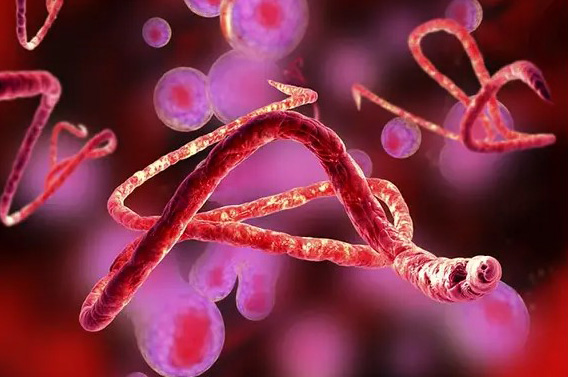Deadly Ebola Outbreak in DR Congo Involving the Highly Virulent Zaire Strain Kills 17 and is Spreading Rapidly
Nikhil Prasad Fact checked by:Thailand Medical News Team Sep 06, 2025 3 months, 3 weeks, 6 days, 15 hours, 5 minutes ago
Medical News: Rising Fears in Kasai Province
Health officials in the Democratic Republic of Congo (DRC) have confirmed a new outbreak of the Ebola virus in Kasai Province, one of the country’s central regions. As of September 6, 2025, the Ministry of Health reported 32 suspected cases, with at least 17 (updated from 15 as of the 6
th of September) confirmed deaths, including four healthcare workers who were on the frontlines. This
Medical News report comes at a time when the region is already battling multiple health and humanitarian emergencies such as cholera, malnutrition, monkeypox and mass displacement of populations due to ongoing conflicts.
 Deadly Ebola Outbreak in DR Congo Involving the Highly Virulent Zaire Strain Kills 17 and is Spreading Rapidly
The Zaire Strain Confirmed
Deadly Ebola Outbreak in DR Congo Involving the Highly Virulent Zaire Strain Kills 17 and is Spreading Rapidly
The Zaire Strain Confirmed
Laboratory analysis conducted on September 3 at the National Institute of Biomedical Research in Kinshasa confirmed that the outbreak is caused by the Ebola Zaire strain, one of the most deadly and fast-spreading forms of the virus. This strain has been responsible for some of the worst Ebola epidemics in history. The first confirmed patient in this outbreak was a 34-year-old pregnant woman admitted to a hospital with high fever and persistent vomiting. She tragically died within hours from multiple organ failure.
Historical Background of Ebola in DRC
The DRC has faced repeated Ebola outbreaks since the virus was first discovered in the country in 1976, near the Ebola River which gave the disease its name. This marks the 16th outbreak in the nation’s history and the first in Kasai since smaller outbreaks in 2007 and 2008. The last outbreak before this occurred in Equateur Province in 2022, which was contained within three months. However, the current outbreak is showing signs of rapid transmission, raising concerns of a wider spread.
Transmission and Risk Factors
Ebola Virus Disease is rare but extremely lethal. It is thought to originate from fruit bats, which act as natural reservoirs for the virus. Human infection typically occurs through direct contact with the blood, organs, or bodily fluids of infected animals. Once it enters human communities, it spreads through direct contact with bodily fluids such as blood, vomit, feces, and even sweat from infected individuals, or through contaminated materials like clothing and bedding.
International and Local Response
The World Health Organization (WHO) has stated that it is working with urgency to control the outbreak and protect communities. WHO officials warned that more cases are expected as the virus continues to spread and stressed the importance of early detection and isolation. The DRC government has deployed response teams and is tracing contacts of confirmed patients to limit transmission. Authorities have also called for strict adherence to preventive measures such as handwashing, social distancing in high-risk areas, and immediate reporting of suspected cases.
&
;nbsp;
The DRC currently holds a reserve stockpile of treatments and has 2,000 doses of the Ervebo vaccine, which is known to be effective against the Ebola Zaire strain. These medical resources are expected to be critical in containing the outbreak and protecting health workers who remain at the highest risk.
The Human Cost and Lessons from the Past
While the current death toll stands at 17, history shows how devastating Ebola can become if not controlled early. Between 2018 and 2020, a prolonged outbreak in eastern DRC killed more than 2,000 people. The disease’s rapid progression, severe symptoms, and high mortality rate continue to make it one of the most feared viruses globally.
Conclusion
The re-emergence of the Ebola Zaire strain in Kasai Province highlights the constant threat of viral diseases in regions where health systems are fragile. The situation is particularly dire given the ongoing humanitarian crises that weaken response capacity. However, lessons from previous outbreaks, the availability of vaccines, and international support provide hope that this outbreak can be contained. The tragedy once again emphasizes the urgent need for stronger health infrastructure, rapid surveillance systems, and preparedness in vulnerable regions. If immediate and coordinated measures are not taken, the number of infections and deaths could climb rapidly, adding yet another chapter of loss in the DRC’s long struggle against Ebola.
Reference:
https://sante.gouv.cd/actualites/reunion-de-coordination-pout-renforcer-la-riposte-contre-le-virus-ebola
For the latest updates on the Ebola outbreak in DRC, keep on logging to Thailand
Medical News.
Read Also:
https://www.thailandmedical.news/news/major-cover-up-europe-currently-has-more-covid-19-infections-and-hospitalization-than-the-same-period-last-year
https://www.thailandmedical.news/news/alarming-covid-19-rise-with-1000-new-infections-in-moldova-due-to-new-xfg-variant
https://www.thailandmedical.news/news/covid-19-infections-and-covid-19-hospitalizations-rising-in-south-korea
